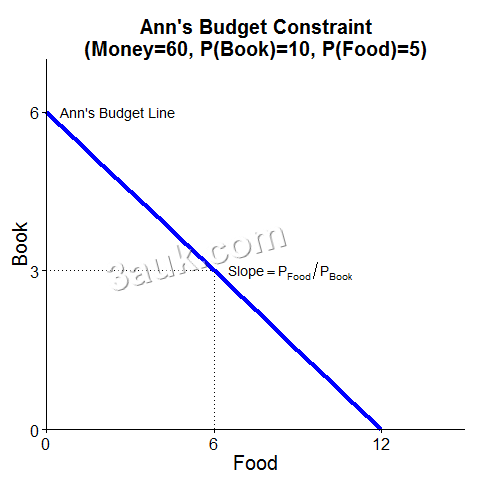Content
- Topic Questions (MCQ – EASY): Indifference curves and budget lines
- Topic Questions (MCQ – HARD): Indifference curves and budget lines
causes of a shift in the budget line

- Changes in income
- An increase in income will shift the budget line outward (to the right), allowing the consumer to afford more of both goods at every price level.
- Conversely, a decrease in income will shift the budget line inward (to the left), reducing the amount of both goods the consumer can afford at every price level.
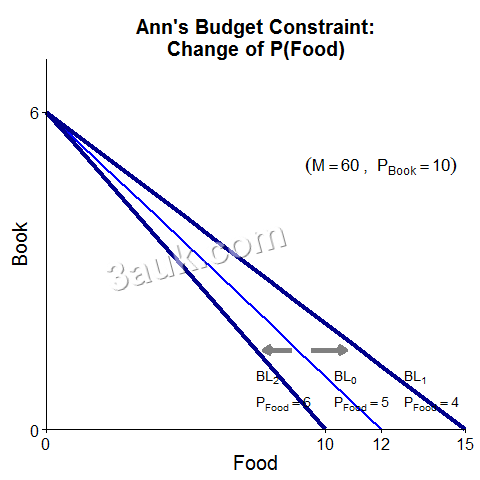
- Changes in the price of one of the goods
- If the price of one good increases while the price of the other remains constant, the budget line will rotate inward, indicating that the consumer can afford less of the more expensive good.
- Conversely, if the price of one good decreases while the price of the other remains constant, the budget line will rotate outward, indicating that the consumer can afford more of the cheaper good.
- Changes in taxes or subsidies: Taxes on a good will effectively increase its price, shifting the budget line inward (to the left). Subsidies on a good will effectively decrease its price, shifting the budget line outward (to the right).
consumer equilibrium in the model of indifference curves and budget line
- Consumer equilibrium is a concept in economics that describes the optimal consumption bundle that maximizes a consumer's satisfaction, subject to their budget constraint.
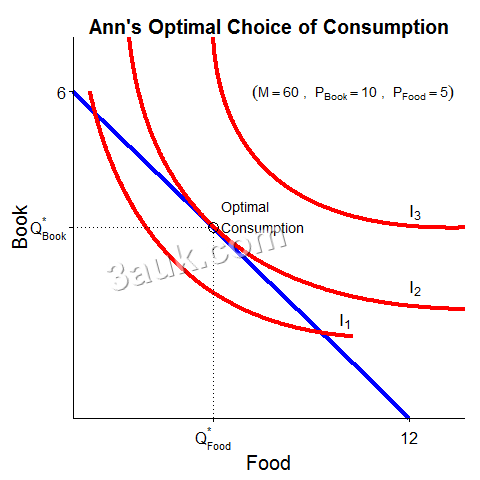
- Consumer equilibrium occurs at the point where the budget line is tangent to the highest possible indifference curve that the consumer can reach, given their budget constraint.
- At this point, the consumer is maximizing their happiness, subject to their budget constraint.
income effect, subsitution effect
- The income effect and substitution effect are two concepts used in economics to explain the change in consumption patterns of a consumer in response to a change in the price of a good.
- The substitution effect occurs when a change in the price of a good causes consumers to substitute one good for another.
- When the price of a good decreases, the consumer will tend to buy more of that good, and less of other goods. This is because the good has become relatively cheaper, and the consumer can now afford to buy more of it without sacrificing the purchase of other goods.
- Conversely, when the price of a good increases, the consumer will tend to buy less of that good, and more of other goods. This is because the good has become relatively more expensive, and the consumer can now afford to buy less of it without sacrificing the purchase of other goods.
- The income effect occurs when a change in the price of a good or income affects the purchasing power of the consumer.
- When the price of a good decreases, the consumer's purchasing power increases because they can now afford to buy more of all goods.
- This is because the money they previously spent on the more expensive good can now be used to purchase additional quantities of all goods.
- Conversely, when the price of a good increases, the consumer's purchasing power decreases because they can now afford to buy less of all goods.
- This is because the money they previously spent on the now more expensive good must be redirected to other goods, leaving less money for all goods.
- When the price of a good decreases, the consumer's purchasing power increases because they can now afford to buy more of all goods.
normal, inferior, Giffen goods
- Normal goods, inferior goods, and Giffen goods are three types of goods that differ in their demand response to changes in price and income.
- Normal goods are goods for which the quantity demanded increases as income increases, ceteris paribus.
- As consumers become more affluent, they tend to purchase more of these goods. Examples of normal goods include luxury goods, such as designer clothes, high-end vehicles, and expensive jewelry.
- Inferior goods are goods for which the quantity demanded decreases as income increases, ceteris paribus.
- Inferior goods are typically goods that consumers view as less desirable or of lower quality than alternatives. As consumers become more affluent, they tend to shift their demand towards more desirable goods.
- Examples of inferior goods include generic products, low-quality clothing, and fast food.
- Giffen goods are a special type of inferior good for which the quantity demanded increases as the price increases, ceteris paribus.
- This is a unique phenomenon where the law of demand is reversed.
- In the case of Giffen goods, consumers view the good as a necessity and are willing to pay a higher price for it, even if their income decreases.
- Examples of Giffen goods are rare, but a common example is potatoes in Ireland during the Irish Potato Famine. As the price of potatoes increased, poorer families could no longer afford other staple foods and had to rely on potatoes as their primary source of nutrition. Therefore, the quantity demanded of potatoes increased, even as the price increased.
analyze the effect of a change in income on the consumption of goods

- For normal goods, an increase in income will result in a positive income effect.
- The income effect will cause the consumer to increase their consumption of the normal goods, as their increased income allows them to afford more of these goods.
- For inferior goods, an increase in income will result in a negative income effect.
- The negative income effect occurs because as the consumer's income increases, they will choose to decrease their consumption of the inferior goods, which are considered to be of lower quality or less desirable than other goods.
income, substitution and price effects for normal, inferior and Giffen goods
Normal goods
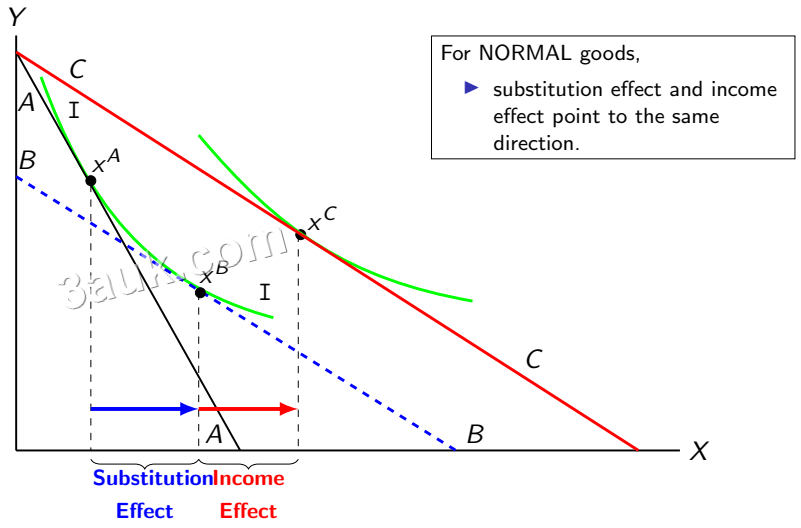
- Substitution effect: If the price of the good decreases, it becomes relatively cheaper, and consumers will tend to substitute other goods with the cheaper good. This will lead to an increase in the quantity demanded of the good.
- Income effect: If the price of the good decreases, the consumer's real income increases, which allows them to purchase more of all goods, including the good in question. This will lead to an increase in the quantity demanded of the good.
- So for normal goods, the substitution effect and income effect caused by a price change affect the consumption of the good in the same direction.
Inferior goods, Giffen goods
- When the price of an inferior good changes, the income effect and the substitution effect have opposite effects on the quantity demanded.
- Substitution effect: If the price of an inferior good decreases, it becomes relatively cheaper, and consumers will tend to substitute other goods with the cheaper good. This will lead to an increase in the quantity demanded of the good.
- Income effect: If the price of an inferior good decreases, the consumer's real income increases, which means that they can now afford to buy more expensive goods that they previously could not. As a result, the consumer will tend to shift away from the inferior good, and towards more expensive substitutes. This will lead to a decrease in the quantity demanded of the inferior good.
- The overall effect on the quantity demanded of the inferior good will depend on the relative strength of these two effects.
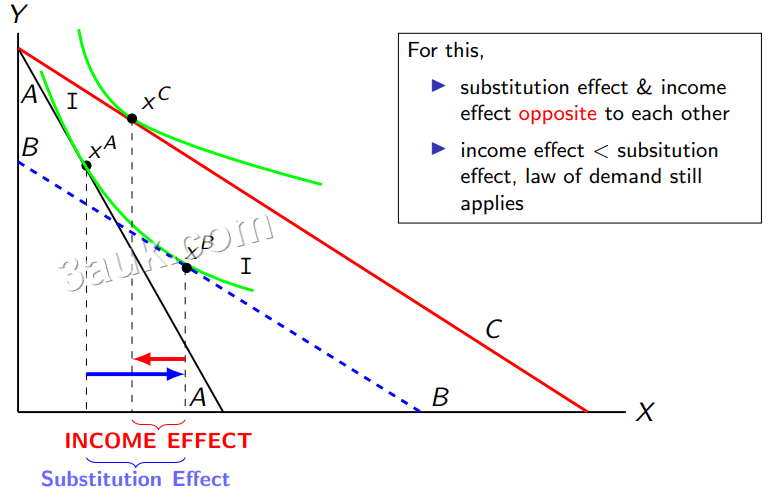
-
- If the substitution effect is stronger than the income effect, the quantity demanded will increase, but by a smaller amount than the price decrease.
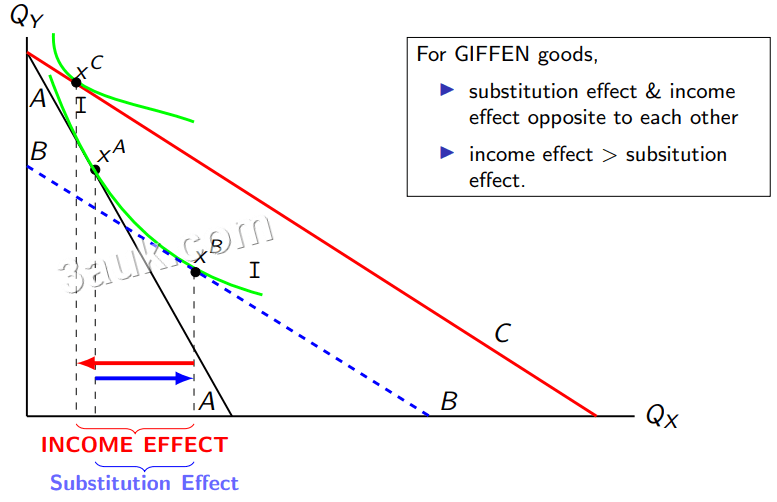
-
- If the income effect is stronger than the substitution effect, the quantity demanded will decrease. - Giffen goods
limitations of the model of indifference curves
- Rationality: The model assumes that consumers are rational and always make choices that maximize their utility. In reality, consumers may not always behave rationally, and their choices may be influenced by factors such as emotions, habits, and limited information.
- More than two goods: The model assumes that consumers are choosing between only two goods. In reality, consumers are often choosing between multiple goods, and the model can become more complex and less accurate when there are more goods to consider.
- Indifference vs rank order: The model assumes that consumers are indifferent between different bundles of goods along an indifference curve. In reality, consumers may not be truly indifferent and may have preferences or rankings among different goods, making it more difficult to accurately model their behavior.
Join the conversation


